Royal
Dental Hospital of London
31-36 Leicester Square, WC2H 7LG
Medical
dates:
Medical
character:
Dental (Out-Patients only)
The Dental Hospital of London
opened on 1st December 1858 at No. 32 Soho Square. It had been established in
order to regulate and improve standards of dental care. A
Dental School opened the following year to provide formal
education and training.
In 1866 chloroform anaesthesia was introduced. Two years later, the Hospital began to use nitrous oxide as an anaesthetic, producing the gas on its premises.
The premises soon became inadequate due to the number of patients seen and, in March 1874 the Hospital moved to Nos. 40-41 Leicester Square, at that time a disreputable area. Treadle drills were introduced, but students were cautioned that the power of them was so great, that the pulp cavity could be invaded before the operator was aware of it.
By 1880 almost 36,000 patients a year were seen and there was a chronic lack of space. An adjoining property, Tower House, was donated to the Hospital by Sir Edwin Saunders.
The efforts to increase resources because of rising demand led to yet more rising demand. In 1886 the Hospital dealt with 43,745 patients - a 12% increase - and nearly double that of the number seen in 1874. The Hospital attempted to incorporate 42 Leicester Square, but difficulties with fire regulations delayed the extension until 1888.
In 1893 the Hospital purchased 35, 35a and 36 Leicester Square, 22-23 Green Street and 1-5 Longs Court, and placed a deposit on The Duke's Head at 37 St Martin's Street - buildings which were all in the same block, to the south of the Square and to the east of St Martin's Street. By 1896 other buildings in the block were bought and the site cleared. In 1897 rebuilding began.
The new Hospital opened in March 1901 under the patronage of King Edward VII and became known as the Royal Dental Hospital of London.
In 1911 the Royal Dental Hospital and London School of Dental Surgery joined the University of London, and offered a License in Dental Surgery and a university Degree in Dental Surgery.
Following WW1 female students were admitted, mainly because of the reduction in male students.
Financial problems and debts slowed down further progress, while rivals began to overshadow the Hospital and School. However, during WW2, the Hospital stayed open while other dental hospitals closed or moved out of London. In 1940 the building was damaged by a landmine, but was quickly repaired and back in service.
In 1948 the Hospital joined the NHS and came under the administration of St George's Hospital Management Committee, part of the London (Teaching) Regional Hospital Board.
Plans to improved the interior of the Hospital were approved in 1957. The Hospital and School were reorganised, the School moving most of its non-clinical facilities into the newly acquired Ciro Club in Orange Street.
During the 1960s and 1970s discussions took place on the transfer of the Royal Dental Hospital to the new site of St George's Hospital and Medical School at Tooting. Staff at the Royal Dental Hospital were unhappy about this at first and tried to delay the move.
In 1974, following a major reorganisation of the NHS, the Hospital came under the control of the Wandsworth and East Merton (Teaching) District Health Authority, part of the South West Thames Regional Health Authority.
In 1976 the preclinical departments of the Dental School relocated to Tooting. St George's Hospital by this time had decided that the dental services required in Tooting were not those that were offered by the Royal Dental Hospital.
The early 1980s were spent negotiating a voluntary merger with the United Medical and Dental Schools of Guy's and St Thomas's Hospitals. This came about in 1983 and the Royal Dental Hospital closed in 1985.
In 1866 chloroform anaesthesia was introduced. Two years later, the Hospital began to use nitrous oxide as an anaesthetic, producing the gas on its premises.
The premises soon became inadequate due to the number of patients seen and, in March 1874 the Hospital moved to Nos. 40-41 Leicester Square, at that time a disreputable area. Treadle drills were introduced, but students were cautioned that the power of them was so great, that the pulp cavity could be invaded before the operator was aware of it.
By 1880 almost 36,000 patients a year were seen and there was a chronic lack of space. An adjoining property, Tower House, was donated to the Hospital by Sir Edwin Saunders.
The efforts to increase resources because of rising demand led to yet more rising demand. In 1886 the Hospital dealt with 43,745 patients - a 12% increase - and nearly double that of the number seen in 1874. The Hospital attempted to incorporate 42 Leicester Square, but difficulties with fire regulations delayed the extension until 1888.
In 1893 the Hospital purchased 35, 35a and 36 Leicester Square, 22-23 Green Street and 1-5 Longs Court, and placed a deposit on The Duke's Head at 37 St Martin's Street - buildings which were all in the same block, to the south of the Square and to the east of St Martin's Street. By 1896 other buildings in the block were bought and the site cleared. In 1897 rebuilding began.
The new Hospital opened in March 1901 under the patronage of King Edward VII and became known as the Royal Dental Hospital of London.
In 1911 the Royal Dental Hospital and London School of Dental Surgery joined the University of London, and offered a License in Dental Surgery and a university Degree in Dental Surgery.
Following WW1 female students were admitted, mainly because of the reduction in male students.
Financial problems and debts slowed down further progress, while rivals began to overshadow the Hospital and School. However, during WW2, the Hospital stayed open while other dental hospitals closed or moved out of London. In 1940 the building was damaged by a landmine, but was quickly repaired and back in service.
In 1948 the Hospital joined the NHS and came under the administration of St George's Hospital Management Committee, part of the London (Teaching) Regional Hospital Board.
Plans to improved the interior of the Hospital were approved in 1957. The Hospital and School were reorganised, the School moving most of its non-clinical facilities into the newly acquired Ciro Club in Orange Street.
During the 1960s and 1970s discussions took place on the transfer of the Royal Dental Hospital to the new site of St George's Hospital and Medical School at Tooting. Staff at the Royal Dental Hospital were unhappy about this at first and tried to delay the move.
In 1974, following a major reorganisation of the NHS, the Hospital came under the control of the Wandsworth and East Merton (Teaching) District Health Authority, part of the South West Thames Regional Health Authority.
In 1976 the preclinical departments of the Dental School relocated to Tooting. St George's Hospital by this time had decided that the dental services required in Tooting were not those that were offered by the Royal Dental Hospital.
The early 1980s were spent negotiating a voluntary merger with the United Medical and Dental Schools of Guy's and St Thomas's Hospitals. This came about in 1983 and the Royal Dental Hospital closed in 1985.
Present status (January 2008)
The building was refurbished and is now the Radisson Blu Edwardian Hampshire Hotel.

The Radisson Blu Edwardian Hampshire Hotel in Leicester Square, previously the Royal Dental Hospital of London (above and below).


Designed in 1915 with a sprung-floored dance hall, the Ciro Club in Orange Street (left) was leased to the Hospital from 1956 to 1985. It has now been converted into administative offices for the National Portrait Gallery.
Smith E, Cotell B 1997 A History of the Royal Dental Hospital of London and School of Dental Surgery, 1858-1985. London, Athlone Press
http://collage.cityoflondon.gov.uk
http://hansard.millbanksystems.com
http://search.lma.gov.uk
www.british-history.ac.uk
www.kingscollections.org
Return to home page